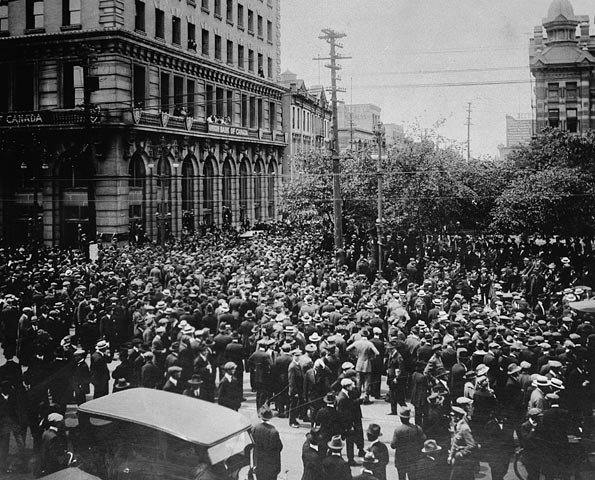Council of Canadians activists gathered in Winnipeg this weekend are dismayed to hear that the Canadian Museum of History has removed its exhibit on the Winnipeg General Strike.
The Toronto Star reports, “The museum [located in Gatineau, Quebec across the river from Ottawa] is clearly sensitive to suggestions of political interference and rejected any notion that the disappearance of the Labour Temple [exhibit] is connected to how the Conservatives feel about organized labour. …The Canadian Museum of History has come under public scrutiny in the past couple of years, following a controversial change in name — it was formerly known as the Canadian Museum of Civilization — and mandate that had critics accusing the Conservative government of using the Crown Corporation to rewrite history in its image.”
“The Canadian Labour Congress, which has not yet been consulted about the changes, expressed concern and called on the museum to include the history of organized labour in its future plans. …New Democrat MP Pat Martin (Winnipeg Centre) was [also] disappointed to learn the room no longer exists.”
The article notes, “The new hall is still in the planning stages, but Chantal Schryer, vice-president of corporate affairs at the museum, said labour history will be included in it. ‘Although we have not completed the selection of content yet, we know that the history of the labour movement in Canada and the Winnipeg General Strike will be highlighted in the new exhibition’.”
We’ll see.
The 100th anniversary of the strike is now less than four years away. The strike, which lasted for 40 days, took place between May 15 and June 25, 1919.
The strike was the largest general strike in Canadian history and is believed to have been the largest in North America. About 30,000 workers, virtually the entire working population of Winnipeg, took to the streets during the strike including the building and metal workers, public transit workers, telephone operators, postal workers, federal workers, water workers, firefighters, newspaper workers, clerical workers, and retail workers. Many of those who took to the streets were non-unionized. Solidarity strikes were called in Calgary, Edmonton, Saskatoon, Prince Albert, Regina, Vancouver, Victoria and many other cities across the country.
The strike was sparked by a series of issues: Manufacturers had made huge profits during the First World War, while workers and soldiers suffered. Soldiers returning home from the war found unemployment, poor working conditions, and low wages. The cost of living had increased by 64 per cent over 1913 because of war-time inflation. The strike was also sparked by business being unwilling to bargain with newly formed umbrella unions, the Building Trades Council and the Metal Trade Council.
Local business leaders formed a secretive “Citizens’ Committee” to oppose the strike and utilized their connections with Prime Minister Robert Borden’s federal government. The Bolshevik revolution had happened in Russia just eighteen months earlier and Ottawa believed the large immigrant population and radicals in Winnipeg wanted revolution.
To counter the general strike, the federal government amended the Immigration Act so that British-born immigrants could be deported and broadened the Criminal Code’s definition of sedition. The federal government also sent in the Royal North-West Mounted Police. By mid-June the federal government had arrested union leaders, banned the Western Labour News, and ordered the RNWMP to stop the ongoing demonstrations. The Winnipeg mayor fired most of the city’s police force, many of whom were sympathetic with the strikers. The police force was replaced by 1,800 special constables who were recruited and paid for by business leaders. The special constables were equipped with a horse and a baseball bat like truncheon.
A pivotal moment came on “Bloody Saturday” June 21, 1919 when war veterans organized a parade to protest the restrictions being placed on them. Six thousand people gathered outside City Hall, then located at William Street and Main Street. A streetcar operated by strikebreakers approached on Main Street. The veterans overturned it and then set it on fire. The RNWMP and special constables riding on horseback charged the crowd. Two strikers (Mike Sokowolski and Mike Schezerbanowicz) were killed by police bullets, at least 34 were wounded, and 94 people were arrested. In the aftermath, the army occupied the city’s streets with machine guns mounted on their vehicles.
Fearing more violence, the workers ended the strike a few days later. A number of the strike leaders arrested just days before Bloody Saturday were later convicted of conspiracy to overthrow the government. They were sentenced to jail terms ranging from six months to two years, one other was deported.
There is an upcoming opportunity to say that this history should be reflected in the Canadian Museum of History. The Board of Trustees of the Canadian Museum of History will be holding its annual public meeting on June 22 (the day after the 96th anniversary of Bloody Saturday) in Winnipeg.
Photo: Crowd gathered outside old City Hall, at Main Street and William Avenue, during the Winnipeg General Strike. Credit: Wikimedia Commons




